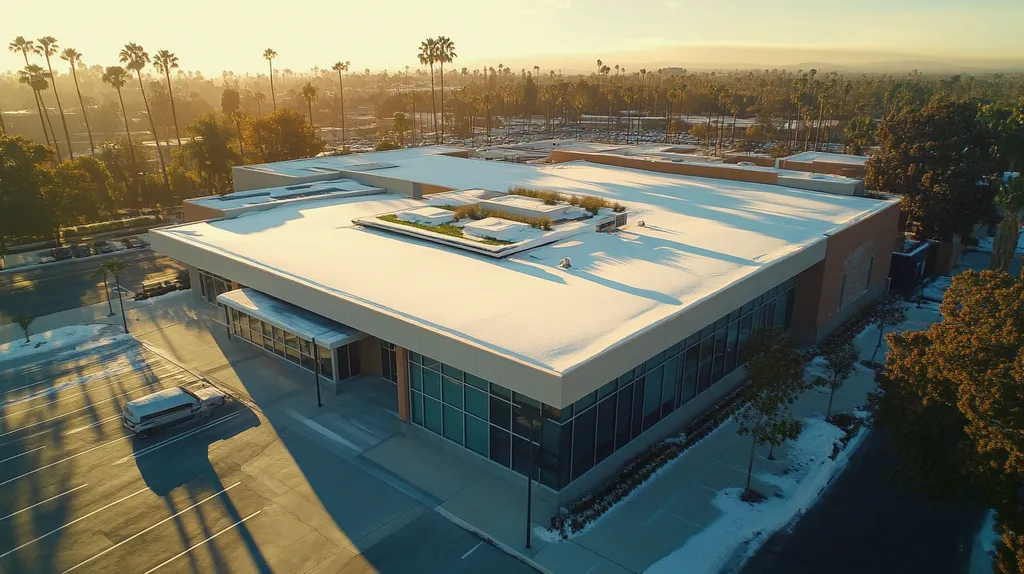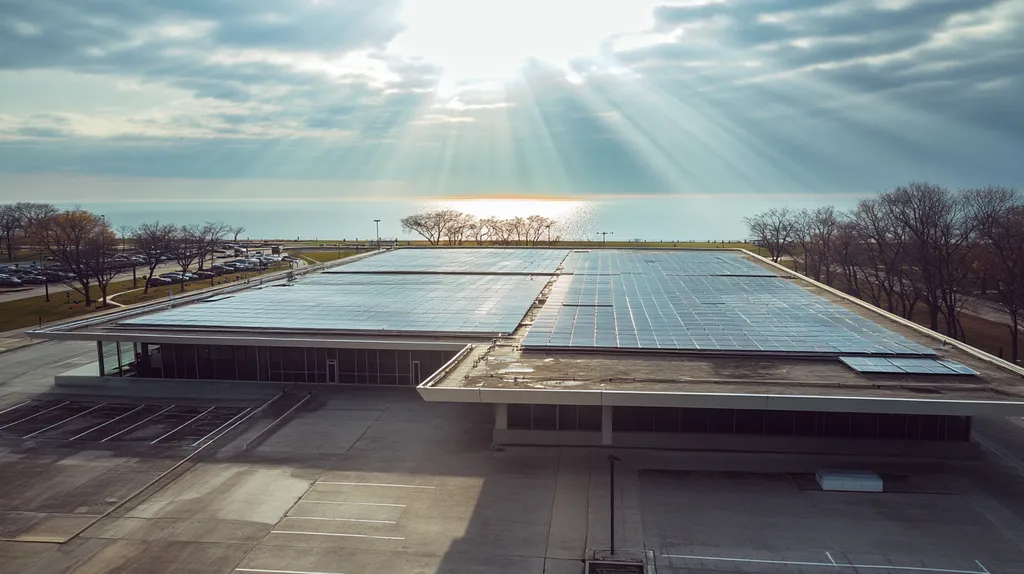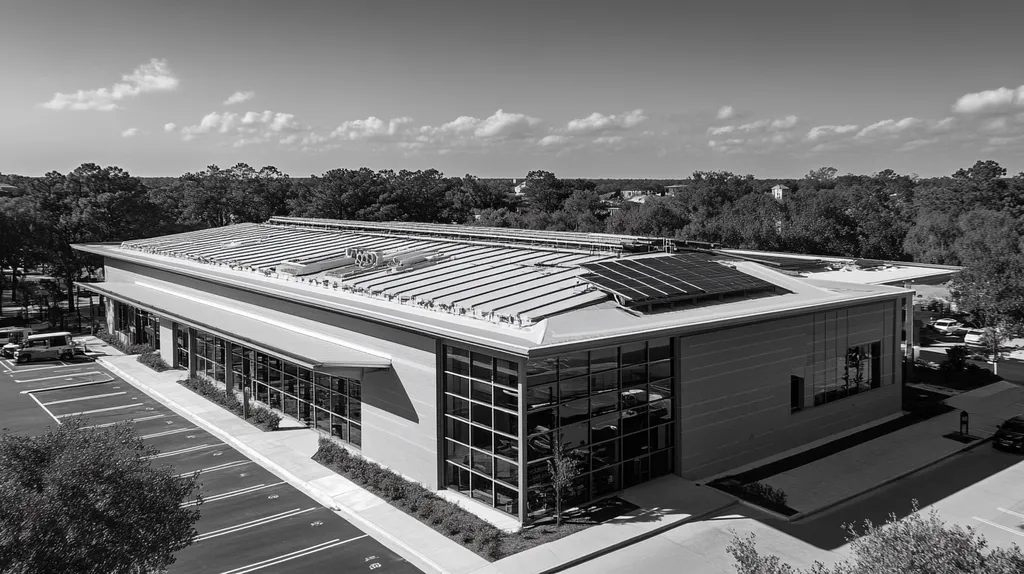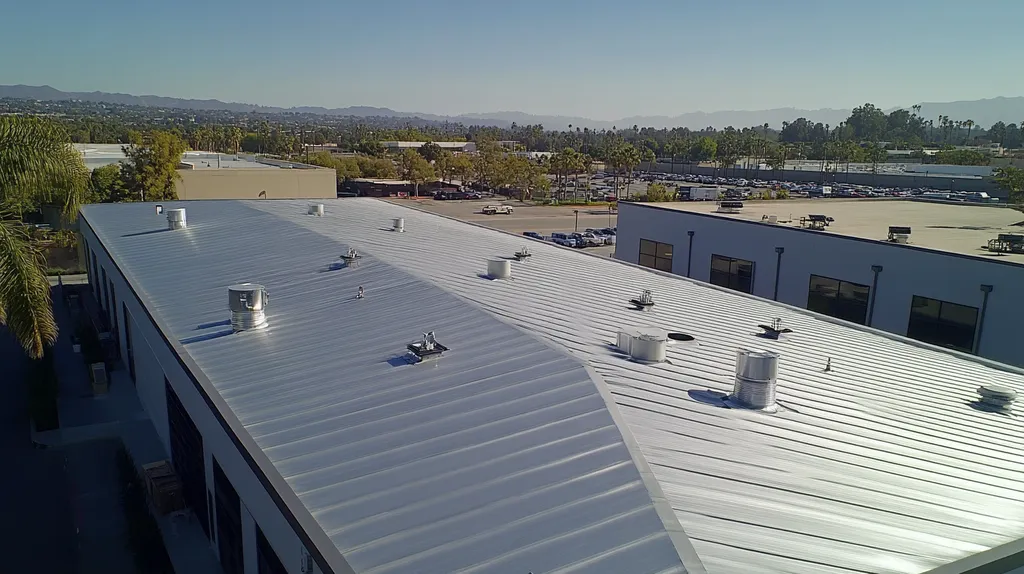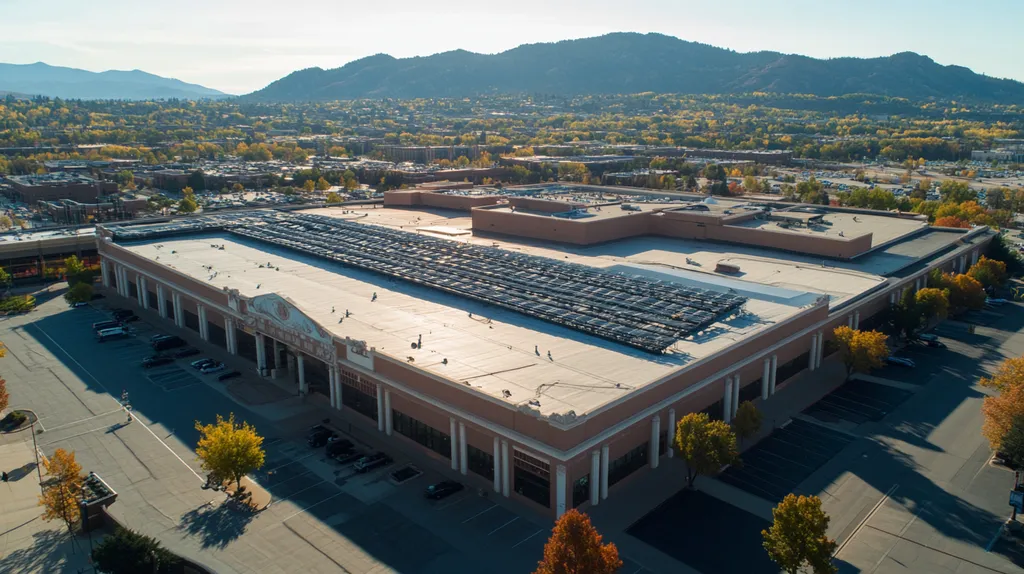In commercial roofing, weather timing can mean the difference between a coating system that lasts 15+ years and one that fails within months. Industry studies show that up to 40% of coating failures stem directly from poor weather-related timing decisions, resulting in over $300 million in preventable damage annually.
With increasingly erratic weather patterns affecting major metropolitan areas, understanding the critical relationship between atmospheric conditions and coating performance has become essential for protecting large-scale roofing investments.
This comprehensive guide examines the key factors that determine optimal coating windows, from temperature and humidity to wind conditions and precipitation forecasting, providing facility managers with actionable insights for successful applications.
SECTION 1: THE BASICS EXPLAINED
The intersection of weather conditions and roof coating applications represents a critical decision point for facility managers and property owners. Recent studies show that improper timing can reduce coating effectiveness by up to 50% and potentially double maintenance costs over a five-year period. With increasingly unpredictable weather patterns affecting major metropolitan areas, understanding the optimal conditions for coating application has become essential for protecting commercial roofing investments.
What It Is (In Plain Language)
A roof coating system acts as a protective shield that waterproofs and reinforces your existing commercial roof surface. Think of it as a seamless membrane that, when properly applied, creates an additional defensive layer against environmental threats.
Temperature, humidity, and precipitation during application directly influence how well this protective layer bonds to your roof. These atmospheric conditions determine whether the coating will cure correctly and achieve its intended performance levels.
Modern coating systems utilize advanced materials that cure through chemical processes, requiring specific environmental conditions. When these conditions aren’t met, the coating may develop issues ranging from minor adhesion problems to complete failure.
Silicone roof coatings have emerged as particularly effective solutions, offering superior protection against ponding water, UV rays, and extreme weather conditions, thanks to their flexibility and high solids content. (source: Karnak Corporation)
Why It Matters (To Your Building)
The financial implications of poorly timed coating applications extend far beyond the initial material and labor costs. When coatings fail prematurely, buildings become vulnerable to water infiltration, increased energy costs, and accelerated deterioration of the underlying roof system.
Energy efficiency represents a significant factor in the equation. Properly applied coatings can reduce roof surface temperatures by up to 60 degrees Fahrenheit, directly impacting cooling costs during summer months.
Warranty coverage often hinges on proper application conditions. Many manufacturers will void coverage if their products are applied outside specified weather parameters, leaving building owners exposed to unexpected repair costs.
Business interruption costs from coating failures can dwarf the initial installation savings. A single roof leak can disrupt operations, damage inventory, and create liability issues that impact the bottom line.
How It Works
The coating process relies on specific chemical reactions that form strong bonds with the roof surface. These reactions are highly sensitive to environmental conditions, particularly temperature and moisture levels.
Different coating types respond uniquely to weather conditions. Water-based acrylics require warmer temperatures and lower humidity, while moisture-cured urethanes can tolerate higher humidity levels but need specific temperature ranges.
Surface preparation effectiveness also depends heavily on weather conditions. Moisture trapped between the coating and roof surface can prevent proper adhesion, leading to blistering and delamination.
The curing process continues well after initial application, sometimes for several days. During this critical period, weather conditions must remain within acceptable ranges to ensure proper film formation and ultimate coating performance.
SECTION 2: PRACTICAL APPLICATIONS
Weather conditions critically impact the success of roof coating applications, with recent industry data showing that improper timing can reduce coating longevity by up to 40%. For facility managers overseeing large commercial properties, understanding these weather-dependent applications has become essential for protecting substantial roofing investments. The stakes are particularly high given that weather-related coating failures often lead to extensive repair costs that could have been avoided through proper timing and application methods.
Common Uses & Examples
Industrial roof coatings primarily serve as protective barriers against environmental threats while enhancing building performance. Modern coating systems can extend roof life by 10-15 years when properly applied under optimal weather conditions.
Large manufacturing facilities frequently utilize reflective coatings to combat heat absorption and reduce cooling costs. These applications require precise temperature and humidity levels during installation to achieve maximum reflectivity and adhesion.
Distribution centers with extensive flat roof areas commonly employ coating systems to prevent water infiltration. This application proves especially critical in regions experiencing frequent temperature fluctuations or heavy rainfall.
Healthcare facilities often choose specialized antimicrobial coatings that require specific environmental conditions during application. These coatings help maintain sterile environments while protecting against moisture intrusion.
When You Need It Most
The success of roof coating applications largely depends on environmental conditions during the coating process. Temperature, humidity, and wind speed directly impact performance, drying time, adhesion, and overall effectiveness.
High humidity conditions can significantly slow drying times and increase the risk of moisture entrapment. Proper weather monitoring becomes essential to avoid premature coating failure or defects that compromise the entire system. (source: Armour Roof Co.)
Spring and fall typically offer ideal application windows, when temperatures remain moderate and precipitation risks are lower. However, these seasons also require careful monitoring of overnight temperatures and dew points.
Emergency repairs following severe weather events demand particular attention to timing. While addressing damage quickly is important, rushing applications during unfavorable conditions often leads to coating failures.
Interactions With Other Systems
Roof coating performance directly relates to the condition and function of adjacent building systems. HVAC units, ventilation systems, and roof penetrations all influence coating effectiveness and durability.
Drainage systems play a particularly crucial role in coating longevity. Proper slope and functional drains prevent water accumulation that can compromise even the highest-quality coating applications.
Solar panel installations and roof-mounted equipment require special consideration during coating applications. These systems can create shaded areas that affect curing times and may require modified application techniques.
Building pressurization systems can impact coating adhesion and curing processes. Proper coordination with facility operations ensures optimal conditions during application and initial curing periods.
SECTION 3: KEY TERMINOLOGY DECODED
The language of roof coating systems represents a critical knowledge gap that costs facility owners millions annually in failed applications and voided warranties. Industry data shows that misunderstanding key terms leads to 30% of coating failures, with particularly devastating effects during weather-sensitive installations. For facility managers and property owners, decoding this technical vocabulary isn’t just about communication – it’s about protecting substantial investments and ensuring long-term building performance.
Essential Terms Explained
Surface preparation terminology forms the foundation of successful coating projects. The “substrate” refers to the existing roof surface that will receive the coating, while “profile” describes the textural characteristics necessary for proper coating adhesion.
Environmental terms directly impact application timing and success. “Dew point” represents the temperature at which moisture condensation occurs, while “ambient temperature” refers to the current air temperature that affects coating cure rates.
Coating-specific terminology includes “dry film thickness” (DFT), which measures the final coating depth after curing. Understanding DFT requirements ensures adequate protection without material waste.
Application-related terms like “pot life” indicate how long mixed materials remain usable, while “recoat window” defines the critical timeframe for applying additional layers.
Industry Jargon Translated
“Viscosity” refers to a coating’s flowability and affects both application methods and coverage rates. Higher viscosity materials require specialized equipment and careful temperature control during application.
“Solar reflectance index” (SRI) measures a coating’s ability to reject solar heat, directly impacting building energy efficiency. Higher SRI values indicate better heat rejection properties.
“Shore hardness” indicates a coating’s resistance to physical damage after curing. This measurement helps predict long-term durability under various environmental conditions.
“VOC content” refers to volatile organic compounds that evaporate during curing. Lower VOC materials offer environmental benefits but may require different application conditions.
Measurement & Units Simplified
Coverage rates typically appear in “square feet per gallon” but vary based on substrate texture and coating thickness. Rough surfaces require significantly more material than smooth ones.
Temperature measurements include both surface and air readings in Fahrenheit. The difference between these readings, known as the “delta T,” can affect moisture condensation and coating adhesion.
Humidity measurements combine relative humidity percentages with dew point calculations. These measurements help predict coating behavior during application and curing phases.
Wind speed measurements in miles per hour determine safe application conditions. Excessive wind speeds can cause uneven coating distribution and contamination from airborne debris.
SECTION 4: DECISION FACTORS
Weather timing decisions in roof coating applications represent a critical intersection of financial risk and building protection. Industry data shows that poorly timed applications can reduce coating effectiveness by up to 70% while increasing lifetime maintenance costs by 3-4 times the initial investment. For facility managers overseeing large commercial properties, understanding these weather-dependent decisions has become essential for protecting substantial roofing investments and avoiding catastrophic system failures.
Cost Considerations
Initial coating application costs represent only a fraction of the total financial impact. Weather conditions during application directly influence labor efficiency, material consumption, and equipment requirements, potentially doubling project costs when conditions are suboptimal.
Rush scheduling to meet budget deadlines often leads to applications during marginal weather conditions. This false economy typically results in premature coating failure and accelerated degradation of the underlying roof system.
Weather-related work stoppages and reapplication requirements can inflate labor costs by 30-50%. Smart scheduling around seasonal weather patterns helps maintain budget control and ensures optimal crew utilization.
Warranty coverage often depends on documented weather conditions during application. Applications outside manufacturer specifications can void coverage, leaving building owners exposed to substantial repair costs.
Performance Trade-offs
Temperature fluctuations and moisture levels during application directly impact coating adhesion and cure rates. Improper curing leads to reduced durability, diminished weather resistance, and potential delamination from the substrate.
UV exposure significantly impacts both initial curing and long-term performance. High temperatures during application can cause thermal expansion and contraction, weakening the roof structure over time and compromising coating integrity. (source: Castagra)
Wind conditions affect application quality and coverage uniformity. Excessive wind speeds during application can result in uneven coating thickness and reduced protection in critical areas.
Seasonal timing influences the development of optimal coating properties. Applications during moderate temperature periods typically achieve better chemical crosslinking and superior physical properties.
Lifespan & Durability Factors
Weather conditions during application establish the foundation for long-term coating performance. Proper timing can extend service life by 40-50% compared to applications made during marginal conditions.
Moisture entrapment between coating layers leads to blistering and adhesion failure. Careful monitoring of dew points and relative humidity helps prevent moisture-related degradation.
Temperature cycling during the critical first 72 hours after application impacts coating flexibility and crack resistance. Applications made during stable weather periods develop superior physical properties.
Surface preparation effectiveness depends heavily on weather conditions. Proper timing ensures optimal substrate cleaning and primer adhesion, creating a more durable coating system.
SECTION 5: COMMON CHALLENGES
Weather-related challenges in roof coating applications represent a critical risk factor for commercial property owners, with industry data showing that improper conditions account for up to 45% of premature coating failures. These failures often result in repair costs 3-4 times higher than the original application. Understanding and effectively managing these challenges has become essential as climate patterns become increasingly unpredictable, particularly in urban environments where building envelope protection is paramount.
Frequent Problems & Solutions
Temperature fluctuations during application represent one of the most significant challenges, particularly in regions with high daily temperature swings. When substrate temperatures vary dramatically from ambient air temperatures, condensation and improper curing can occur.
Environmental conditions during application directly impact performance, drying time, adhesion, and overall effectiveness. Higher humidity levels can significantly slow drying times and increase the risk of moisture entrapment, while wind can introduce contamination that compromises coating integrity. (source: Armour Roof Co.)
Surface preparation challenges intensify during adverse weather conditions. Moisture, dew, and rapid temperature changes can prevent proper substrate cleaning and primer adhesion.
Solutions include implementing weather monitoring protocols, utilizing moisture detection equipment, and maintaining flexible scheduling to accommodate optimal application windows.
Warning Signs To Watch For
Early indicators of weather-related coating issues include blistering and bubbling, which typically appear within the first few weeks after application. These defects often indicate trapped moisture or improper curing conditions.
Adhesion failures manifest through delamination and peeling, particularly at seams and transitions. Regular inspection of these areas can identify problems before they spread across larger sections.
Color inconsistencies and surface texture variations often signal application during suboptimal conditions. These aesthetic issues frequently precede more serious performance problems.
Ponding water that remains for more than 48 hours indicates potential coating compromise, especially when combined with visible surface changes or membrane softening.
Preventative Approaches
Successful preventative strategies begin with comprehensive weather monitoring systems that track temperature, humidity, and wind conditions. These systems should provide both real-time data and predictive forecasting.
Material selection must account for local climate patterns and seasonal variations. Modern coating systems offer enhanced moisture tolerance and temperature stability, but require strict adherence to application parameters.
Quality control protocols should include detailed documentation of environmental conditions throughout the application process. This documentation proves essential for warranty compliance and troubleshooting.
Staff training programs must emphasize weather-related quality indicators and provide clear decision-making guidelines for continuing or suspending application activities.
SECTION 6: NEXT STEPS & RESOURCES
The relationship between weather conditions and roof coating success represents a critical decision point for property owners, with industry data showing that optimal timing can extend coating life by up to 50%. Recent studies indicate that weather-related coating failures account for nearly 40% of premature system breakdowns, leading to repair costs often exceeding three times the initial investment. Understanding and implementing proper weather-based protocols has become essential for protecting commercial roofing assets.
Questions To Ask Providers
Start by evaluating the provider’s experience with your specific climate zone and building type. Request detailed explanations of their weather monitoring protocols and how they incorporate seasonal patterns into project planning.
Discuss specific product selections and their weather-related performance characteristics. Quality providers should explain how different coating types respond to local temperature ranges, humidity levels, and precipitation patterns.
Request documentation of their quality control procedures for weather-sensitive applications. This should include specific measurement protocols, acceptance criteria, and methods for tracking environmental conditions throughout the project.
Examine their contingency planning for weather-related interruptions. Understanding how they handle unexpected conditions helps evaluate their professionalism and ability to protect your investment.
Industry Standards & Guidelines
Temperature, humidity, and wind speed critically affect coating application quality. Higher humidity levels can significantly slow drying times and increase the risk of moisture entrapment, while wind can introduce contamination that compromises coating integrity. (source: Armour Roof Co.)
The National Roofing Contractors Association (NRCA) provides comprehensive guidelines for weather-dependent applications. These standards establish minimum requirements for environmental conditions during coating installation.
ASTM International maintains specific testing protocols for coating performance under various weather conditions. These standards help ensure consistent quality and provide benchmarks for evaluating installation success.
Local building codes often include weather-related requirements specific to your region. Understanding these regulations helps ensure compliance and optimal performance in your climate zone.
Further Learning Simplified
Professional certification programs offer structured learning paths for understanding weather impacts on coating performance. These programs typically include both technical training and practical application guidance.
Industry publications provide regular updates on emerging coating technologies and application methods. Following these resources helps stay current with evolving best practices for weather-sensitive installations.
Manufacturing partners often offer technical bulletins and application guides specific to their products. These resources provide detailed information about weather-related performance characteristics and installation requirements.
Regional roofing associations frequently conduct workshops addressing local weather challenges. These events offer valuable networking opportunities and practical insights from experienced professionals.
The Bottom Line
With weather-related coating failures costing the commercial roofing industry over $300 million annually, proper timing has become the critical factor between success and catastrophic failure.
Modern weather monitoring technology and advanced coating materials provide unprecedented opportunities to optimize application timing, yet 40% of premature failures still stem from poor weather-related decisions.
Facility managers who implement comprehensive weather protocols, maintain flexible scheduling, and partner with experienced contractors can expect coating lifespans to increase by 40-50% compared to rushed applications.
As climate patterns become increasingly unpredictable, the stakes for proper weather timing have never been higher for protecting commercial roofing investments and avoiding costly systemic failures.
FREQUENTLY ASKED QUESTIONS
Q. How does weather affect commercial roof coating timing?
A. Weather conditions, such as temperature and humidity, significantly impact coating performance. Proper timing ensures effective bonding and long-lasting protection for your roof system.
Q. What is the ideal weather for industrial roof coatings?
A. Ideal conditions typically include moderate temperatures and low humidity, especially during spring and fall. Monitoring weather trends helps identify the best times for application.
Q. What key terms should I know about commercial roof coatings?
A. Understanding terms like “substrate,” “dew point,” and “dry film thickness” is essential. These concepts play a crucial role in ensuring successful coating applications.
Q. What factors influence the timing of commercial roof coating applications?
A. Key factors include temperature fluctuations, humidity levels, and wind speed. These elements dictate coating performance and adherence during application.
Q. What challenges arise in industrial roof coating applications?
A. Common challenges include temperature fluctuations and high humidity, which can hinder drying and adhesion. Implementing monitoring protocols helps mitigate these risks.
Q. How can I find reliable resources for roof coating applications?
A. Look for industry publications, certification programs, and local workshops. These resources provide valuable insights into best practices and emerging technologies for roof coatings.
Q. How can I ensure quality during application of commercial roof coatings?
A. Establish clear communication with your providers, monitor weather conditions, and adhere to manufacturer guidelines. Proper preparation and documentation are key to successful applications.

